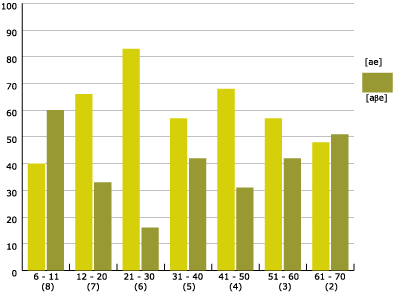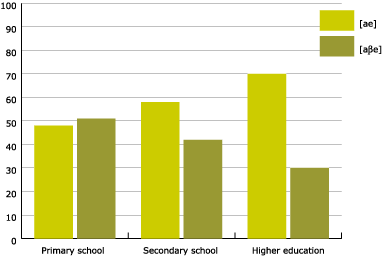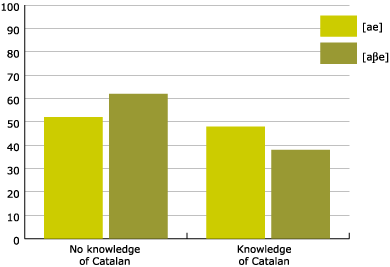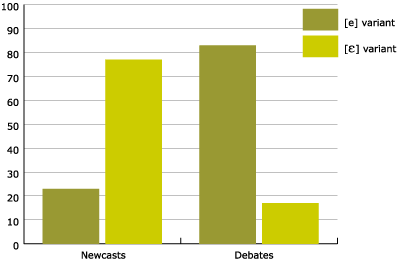
| Variation in the verb in the SegriÓ:
the pronunciation of the third-person morpheme in different contexts of use, by Josefina Carrera-SabatÚ |
||||
| CONTINUA |
a) Effect of age factor Analysis of the results in table 1 shows that almost all interviewees have a high probability factor when it comes to maintaining the traditional form of the third person morpheme, which is clearly not dropping out of use. At the same time, it can be seen that the interviewees aged 6 to 11 are the only ones who show a low probability factor for maintenance of the [e] (0.28). These results can be explained, as I have already observed in other studies of the Lleida dialect (see Creus, 1997; Carrera-SabatÚ, 2002b), by the influence exerted by the schools' speech model on the speech of their students. This influence becomes less strong when the speakers move on to higher or further education, as can be seen in the studies by Aniansson (1979) and Portz (1979), on Swedish and English respectively, and this is evident too, in the results from the respondents aged 21 to 30 in our Alguaire study, who have had schooling in Catalan. b) The influence of schooling and knowledge of written Catalan Taking these two
variables overall, neither alters the probability of maintenance of the traditional [e]
variant to any significant extent. It should be noted, nonetheless, that there is a group
of speakers with a greater probability of alternating between [e] and [ If we cross the data from the variables age, knowledge of written Catalan and schooling, we observe straightaway that all interviewees with knowledge of the written language maintain the [e] less consistently than those who have none. Having said that, if we analyse the behaviour of speakers aged from 41 to 70, some with knowledge of written Catalan and others not, we see little divergence and only in the 51 to 60 age group do the differences in maintenance of the [e] approach 20 %: Figure 1. Percentage maintenance of the [e] realisation
Apart from this, the combination of educational level with age group brings the following to light: 1) In the 51 to 70 age group, and more especially in the 51 to 60 age group, the interviewees with secondary education produce least [e], followed closely by those with higher education. 2) In the 31 to 40 age group, interviewees with higher education use significantly less [e] than those with only secondary education. 3) Among speakers aged from 21 to 30 years, who were the first to be actually educated in Catalan (so older speakers obtained knowledge of written Catalan outside school, if at all), these show a maintenance of the [e] variant at a different level of frequency from the other age groups (see figure 2): speakers with higher education maintain the [e] more than 90 % of the time, and in contrast, those with secondary education, do so at rather more than 10 %. Clearly then, on this showing, speakers with higher education are more conscious than others about the issue of conserving native dialect features. 4) The interviewees aged from 12 to 20 are the ones that least use the [e] variant, although analysis of the probability indices do not show them to be the most innovative speakers. Figure 2. Percentage maintenance of the [e] realisation
4.1.2 The interview and the conversations Analysis of less
formal speech from the 30 inhabitants of Alguaire point to very different conclusions from
those to be drawn from the questionnaire with its closed questions. In general, the final
vowel of the third person of the imperfect, the conditional and the present indicative in
verbs of the first conjugation, practically always gets realised as [e]. Only in the case
of two interviewees (a young girl and a young boy) in the 6-11 years age group did we note
the variant [ Apart from this
observation, the analysis of the verb inflection for the 3rd person of the imperfect
indicative of the verbs of the first conjugation show great variability among the
interviewees, in parallel with the development of this morpheme in LleidatÓ:
1) [a j e], the least commonly used form, noted in only two interviewees: 2
realisations in a man in the 61 to 70 age group and 1 realisation in a woman in the 51 to
60 age bracket, both with primary education and no knowledge of the written language. 2)
[a e] occurring at quite a high level of frequency, in contrast to what was observed in
the questionnaire and its closed questions, where it did not occur at all. 3) [a We have seen that linguistic factors themselves are not relevant when it comes to explaining or characterising variation in the 3rd person ending. If we analyse the incidence of social factors we see once again how the data can be ordered in terms of age, education and knowledge of Catalan. It should be noted, however, that the results did not all reach significance. (15) In the case of the
age factor, we note a higher incidence of [a e] than [a B e] in all age groups except
among speakers aged 61 to 70, who use both forms at an approximately equal rates, and
those aged 6 to 11, who produce [a Figure 3. Realisations of the -va morpheme by age In the case of educational level, there is increasing use of the [a e] covarying with increased education: Figure 4. Realisations of the -va morpheme by educational level
In terms of
knowledge of (written) Catalan, the variant [a e] occurs 24 % more than [a Figure
5. Realisations of the -va morpheme by knowledge
In samples culled
from the Lleida television broadcasts, the use of the [e] and Figure 6. Realisations of the 3 variant on Lleida television
|
![Figure1. Percentage maintenance of the [e] realisation](grafics_carrera/figure1_carrera.gif)
![Figure 2. Percentage maintenance of the [e] realisation](grafics_carrera/figure2_carrera.gif)



